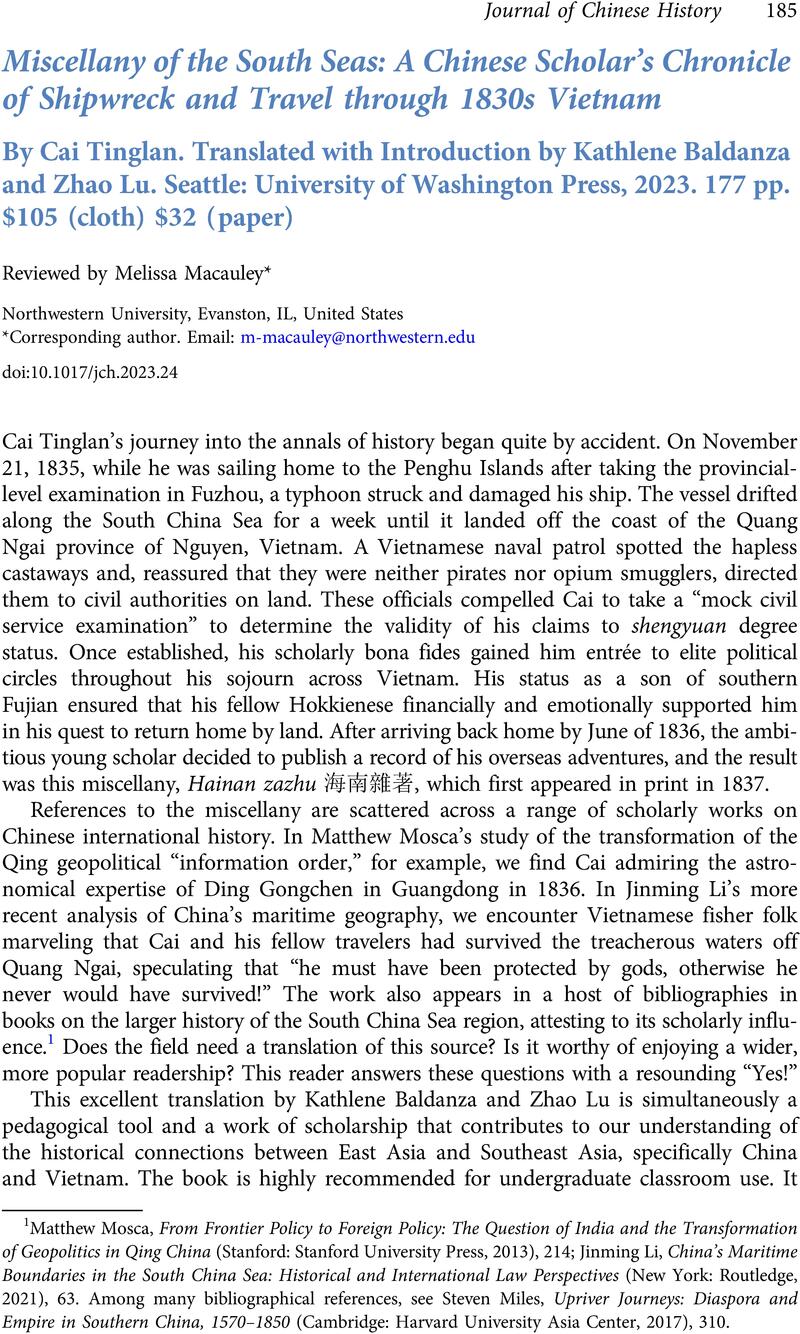No CrossRef data available.
Article contents
Miscellany of the South Seas: A Chinese Scholar's Chronicle of Shipwreck and Travel through 1830s Vietnam By Cai Tinglan. Translated with Introduction by Kathlene Baldanza and Zhao Lu. Seattle: University of Washington Press, 2023. 177 pp. $105 (cloth) $32 (paper)
Review products
Published online by Cambridge University Press: 12 October 2023
Abstract

- Type
- Book Review
- Information
- Copyright
- Copyright © The Author(s), 2023. Published by Cambridge University Press
References
1 Mosca, Matthew, From Frontier Policy to Foreign Policy: The Question of India and the Transformation of Geopolitics in Qing China (Stanford: Stanford University Press, 2013), 214Google Scholar; Li, Jinming, China's Maritime Boundaries in the South China Sea: Historical and International Law Perspectives (New York: Routledge, 2021), 63Google Scholar. Among many bibliographical references, see Miles, Steven, Upriver Journeys: Diaspora and Empire in Southern China, 1570–1850 (Cambridge: Harvard University Asia Center, 2017), 310Google Scholar.
2 Woodside, Alexander, Vietnam and the Chinese Model: A Comparative Study of Vietnamese and Chinese Government in the First Half of the Nineteenth Century (Cambridge: Harvard East Asian Monographs, 1988), preface, n.pGoogle Scholar.
3 The translators refer to Macauley, Melissa, Distant Shores: Colonial Encounters on China's Maritime Frontier (Princeton: Princeton University Press, 2021)Google Scholar.
4 Heidhues, Mary Somers, Golddiggers, Farmers, and Traders in the “Chinese Districts” of West Kalimantan, Indonesia (Ithaca: Cornell University Press, 2003)CrossRefGoogle Scholar; Trocki, Carl, Opium and Empire: Chinese Society in Colonial Singapore, 1800-1910 (Ithaca: Cornell University Press, 1990)Google Scholar; Trocki, Carl, Prince of Pirates (Singapore: Singapore University Press, 1979)Google Scholar.
5 Andaya, Barbara and Andaya, Leonard, A History of Malaysia (Honolulu: University of Hawai‘i Press, 2001), 139–47Google Scholar; Heidhues, Golddiggers, Farmers, and Traders, 50–55.
6 Anh Sy Huy Le, “Southern Vietnam as a Chinese Colony: Dao Trinh Nhat, State-Induced Migration, and the Perils of Chinese Migrants,” paper presented at the Annual Meeting of the AAS, Honolulu, 2022.
7 Tinglan, Cai, Hainan zazhu (Taipei: Taiwan yinhang, 1959), 40Google Scholar.
8 Woodside (Vietnam and the Chinese Model, 4) asserted that the massacre reflected Tay Son rebel opposition to the “plural society” developing in Vietnam at this time. More recently, Choi Byung Wook has claimed that it was the result of the military involvement of Chinese settlers in the political struggles of the day. See his Southern Vietnam Under the Reign of Minh Mang (1820-1841) (Ithaca: Cornell Southeast Asia Publications, 2004), 36–37Google Scholar.



